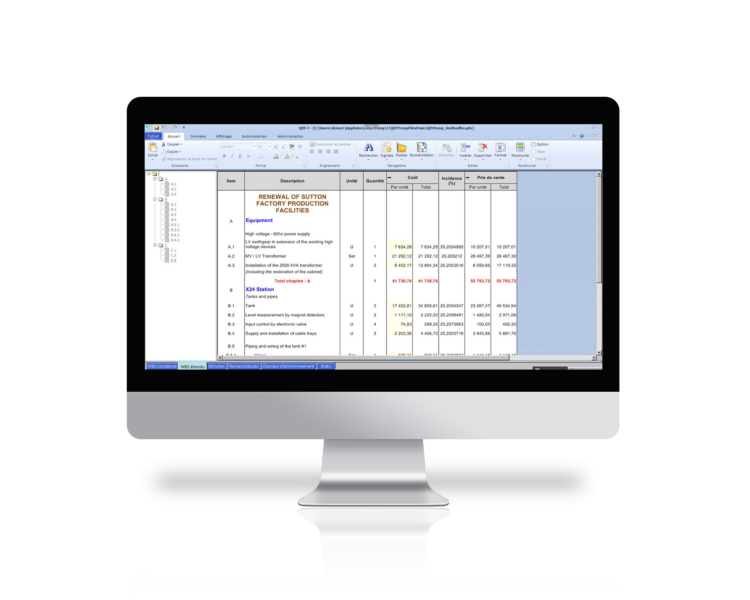Accurate cost estimation is essential for construction or industrial companies. Industry professionals must be able to accurately determine the costs associated with a project to make informed decisions and ensure profitability. However, traditional price estimation methods have limitations in terms of accuracy, efficiency and data management. This is where automation with pricing research software comes into play.
Challenges of traditional price estimation methods
Manual methods and spreadsheets were once the preferred means of estimating costs in the construction or manufacturing industry. However, these approaches had significant limitations. Manual calculations were prone to human error , which could lead to inaccurate estimates and cost overruns . Additionally, collecting and managing cost data was often tedious and time-consuming .

The benefits of automation with pricing research software
There are many benefits to adopting pricing research software These modern tools make it possible to automate the estimation process , which improves the precision of calculations and reduces the risk of errors . Cost data is centralized, making essential information easy to access.
Additionally, pricing research software offers the ability to quickly generate detailed and personalized reports , saving valuable time.
Finally, with the highest software, such as QDV , you can follow the progress of the project.
The costs can feed into a schedule which will make possible the dynamic analysis of the cash flow ( cash flow curve) to quickly identify possible discrepancies.

Steps to Automate Your Estimates with Pricing Software
- Selecting the right pricing research software suited to your needs:
When selecting pricing research software, consider the specific features you need. Analyze the options available in the market, compare features and user interface, and make sure the software matches your requirements in terms of project size, industry, and types of costs to be estimated.
- Collection and integration of cost data into the software:
Once pricing research software has been chosen, it is essential to collect and integrate relevant cost data into the system. This may include costs for materials, labor, equipment, subcontractors, etc. Be sure to collect reliable data from a variety of sources, such as suppliers, cost databases, or past estimates. Import this data into the pricing research software in an organized and structured manner.
- Configuring parameters and formulas for automatic calculations:
Once the data is integrated, it's time to configure the parameters and formulas in the software. This will allow the software to perform the automatic calculations necessary to generate the estimates. For example, define labor rates, markup factors, material prices, etc. Make sure you understand the functionality of the software and configure the calculations according to your specific methods and preferences.
- Setting up configurators:
Configurators in pricing research software provide a valuable advantage by simplifying the process of creating estimates. With these intuitive tools, users can quickly customize their project settings , resulting in more accurate quotes tailored to each client's specific needs. This results in significant time savings and improved customer satisfaction, thus strengthening the competitiveness of the company. Your price study software thus becomes a real CPQ (Configure, Price, Quote) tool.
- Using advanced features for in-depth cost analysis:
Pricing research software often offers advanced features for detailed cost analysis. Take advantage of these features to get detailed reports, cost comparisons, batch estimates, sensitivity analyses, and more. Use graphs, tables and visual indicators to better understand cost components and identify areas where adjustments may be necessary.
By following these steps, you will be able to automate your pricing estimates with effective pricing research software. It is important to spend time on the initial setup and configuration of the software in order to obtain accurate and relevant results. Remember that the quality of the data you integrate and a good understanding of the software's functionalities are essential to obtaining reliable and optimized estimates.
Best Practices for Successful Estimation Automation
To take full advantage of estimation automation, it's important to follow some best practices. First, make sure you train and familiarize users with the software . This will ensure optimal use of all the features offered.
Then, keep the data regularly updated to ensure its relevance and timeliness. It is also recommended to monitor and evaluate the results obtained from automated estimates. This will allow you to make necessary adjustments and continually improve your estimation processes.
Convincing results thanks to the automation of estimates
Many companies have already adopted pricing research software to automate their estimates. These companies have seen significant gains in accuracy, efficiency and productivity. For example, a construction company was able to reduce the time spent on estimates by 50% using automation. Another company in the industrial sector saw a reduction in calculation errors of almost 80%. These concrete examples demonstrate the positive impact of estimating automation.

Automating estimates with price study software offers numerous advantages for professionals in construction, construction and industry. It helps improve the accuracy of estimates, save valuable time, reduce the risk of errors and make more informed decisions. By following key steps and best practices, you can successfully automate your estimates and improve the efficiency of your business . Don't delay in adopting pricing research software to optimize your cost estimating processes and boost your success in the construction industry.
During a 20-minute video, our QDV integrator-expert will take stock of your pricing practices and estimate the time you could save thanks to QDV.




